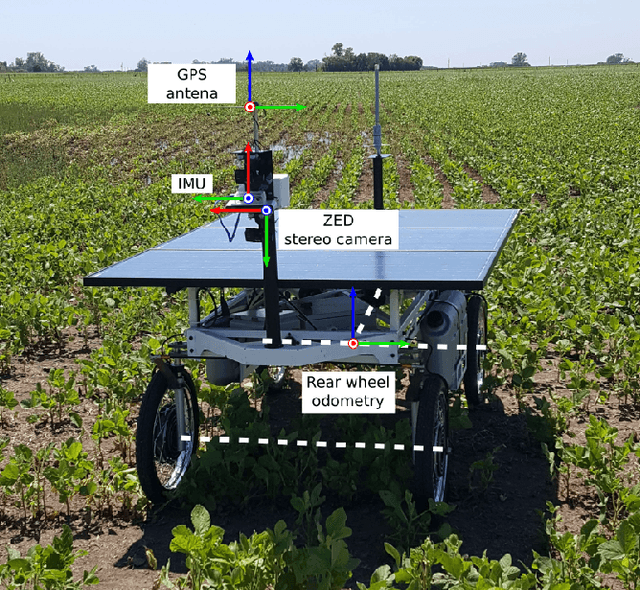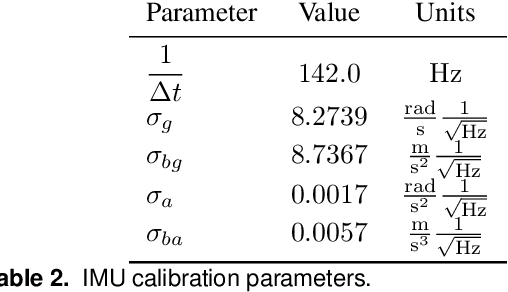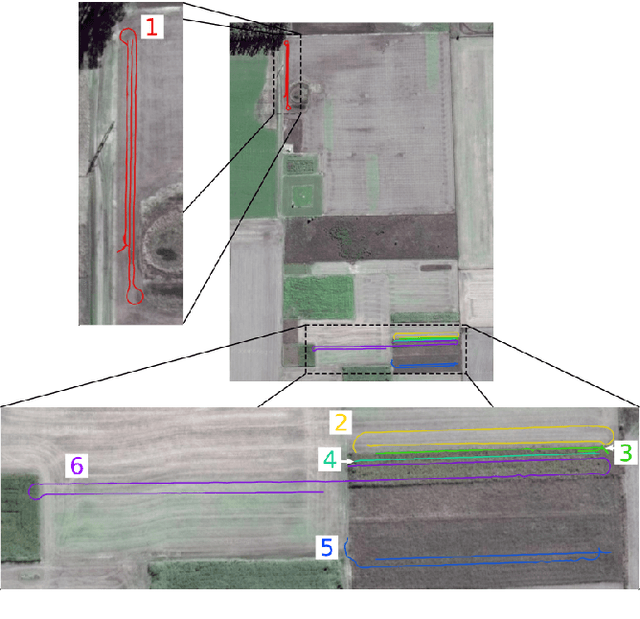Taihú Pire
Addressing the challenges of loop detection in agricultural environments
Aug 30, 2024

Abstract:While visual SLAM systems are well studied and achieve impressive results in indoor and urban settings, natural, outdoor and open-field environments are much less explored and still present relevant research challenges. Visual navigation and local mapping have shown a relatively good performance in open-field environments. However, globally consistent mapping and long-term localization still depend on the robustness of loop detection and closure, for which the literature is scarce. In this work we propose a novel method to pave the way towards robust loop detection in open fields, particularly in agricultural settings, based on local feature search and stereo geometric refinement, with a final stage of relative pose estimation. Our method consistently achieves good loop detections, with a median error of 15cm. We aim to characterize open fields as a novel environment for loop detection, understanding the limitations and problems that arise when dealing with them.
Revisión de Métodos de Planificación de Camino de Cobertura para Entornos Agrícolas
Jul 02, 2024Abstract:The use of an efficient coverage planning method is key for autonomous navigation in agricultural environments, where a robot must cover large areas of crops. This paper generally reviews the current state of the art of coverage path planning methods. Two widely used techniques applicable to agricultural environments are described in detail. The first consists of breaking down a complex field with obstacles into simpler subregions known as cells, to subsequently generate a coverage pattern in each of them. The second analyzes spaces composed of parallel strips through which the robot must circulate, in order to find the optimal order of visiting strips that minimizes the total distance traveled. Additionally, the combination of both techniques is discussed in order to obtain a more efficient global coverage plan. This analysis was conceived to be implemented with the soybean crop weeding robot developed at CIFASIS (CONICET-UNR).
GNSS-stereo-inertial SLAM for arable farming
Jul 24, 2023Abstract:The accelerating pace in the automation of agricultural tasks demands highly accurate and robust localization systems for field robots. Simultaneous Localization and Mapping (SLAM) methods inevitably accumulate drift on exploratory trajectories and primarily rely on place revisiting and loop closing to keep a bounded global localization error. Loop closure techniques are significantly challenging in agricultural fields, as the local visual appearance of different views is very similar and might change easily due to weather effects. A suitable alternative in practice is to employ global sensor positioning systems jointly with the rest of the robot sensors. In this paper we propose and implement the fusion of global navigation satellite system (GNSS), stereo views, and inertial measurements for localization purposes. Specifically, we incorporate, in a tightly coupled manner, GNSS measurements into the stereo-inertial ORB-SLAM3 pipeline. We thoroughly evaluate our implementation in the sequences of the Rosario data set, recorded by an autonomous robot in soybean fields, and our own in-house data. Our data includes measurements from a conventional GNSS, rarely included in evaluations of state-of-the-art approaches. We characterize the performance of GNSS-stereo-inertial SLAM in this application case, reporting pose error reductions between 10% and 30% compared to visual-inertial and loosely coupled GNSS-stereo-inertial baselines. In addition to such analysis, we also release the code of our implementation as open source.
Experimental Evaluation of Visual-Inertial Odometry Systems for Arable Farming
Jun 10, 2022



Abstract:The farming industry constantly seeks the automation of different processes involved in agricultural production, such as sowing, harvesting and weed control. The use of mobile autonomous robots to perform those tasks is of great interest. Arable lands present hard challenges for Simultaneous Localization and Mapping (SLAM) systems, key for mobile robotics, given the visual difficulty due to the highly repetitive scene and the crop leaves movement caused by the wind. In recent years, several Visual-Inertial Odometry (VIO) and SLAM systems have been developed. They have proved to be robust and capable of achieving high accuracy in indoor and outdoor urban environments. However, they were not properly assessed in agricultural fields. In this work we assess the most relevant state-of-the-art VIO systems in terms of accuracy and processing time on arable lands in order to better understand how they behave on these environments. In particular, the evaluation is carried out on a collection of sensor data recorded by our wheeled robot in a soybean field, which was publicly released as the Rosario Dataset. The evaluation shows that the highly repetitive appearance of the environment, the strong vibration produced by the rough terrain and the movement of the leaves caused by the wind, expose the limitations of the current state-of-the-art VIO and SLAM systems. We analyze the systems failures and highlight the observed drawbacks, including initialization failures, tracking loss and sensitivity to IMU saturation. Finally, we conclude that even though certain systems like ORB-SLAM3 and S-MSCKF show good results with respect to others, more improvements should be done to make them reliable in agricultural fields for certain applications such as soil tillage of crop rows and pesticide spraying.
WGANVO: Monocular Visual Odometry based on Generative Adversarial Networks
Jul 27, 2020



Abstract:In this work we present WGANVO, a Deep Learning based monocular Visual Odometry method. In particular, a neural network is trained to regress a pose estimate from an image pair. The training is performed using a semi-supervised approach. Unlike geometry based monocular methods, the proposed method can recover the absolute scale of the scene without neither prior knowledge nor extra information. The evaluation of the system is carried out on the well-known KITTI dataset where it is shown to work in real time and the accuracy obtained is encouraging to continue the development of Deep Learning based methods.
The Rosario Dataset: Multisensor Data for Localization and Mapping in Agricultural Environments
Mar 08, 2019



Abstract:In this paper we present The Rosario Dataset, a collection of sensor data for autonomous mobile robotics in agricultural scenes. The dataset is motivated by the lack of realistic sensor readings gathered by a mobile robot in such environments. It consists of 6 sequences recorded in soybean fields showing real and challenging cases: highly repetitive scenes, reflection and burned images caused by direct sunlight and rough terrain among others. The dataset was conceived in order to provide a benchmark and contribute to the agricultural SLAM/odometry and sensor fusion research. It contains synchronized readings of several sensors: wheel odometry, IMU, stereo camera and a GPS-RTK system. The dataset is publicly available in http://www.cifasis-conicet.gov.ar/robot/.
 Add to Chrome
Add to Chrome Add to Firefox
Add to Firefox Add to Edge
Add to Edge